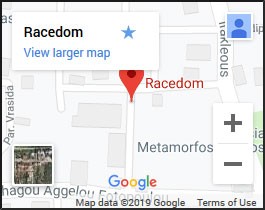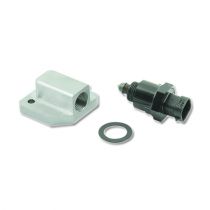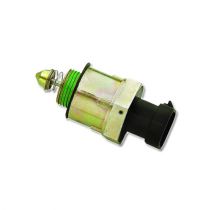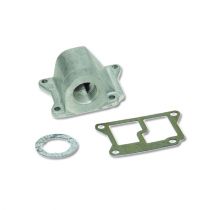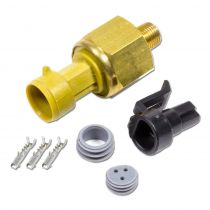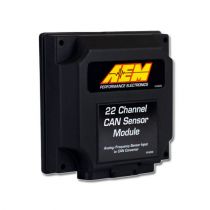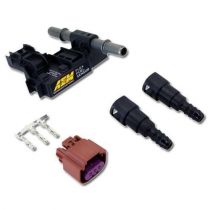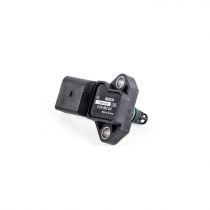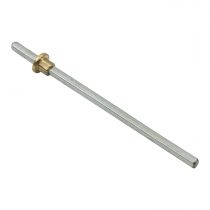Innovate Motorsports 3834 Induktive Klemme Zubehör-Set, U/min Pick-Up für LM-2, LMA-2, LMA-3,DLl-32
CARBURATOR CENTRAL
Wideband Tuning for Carbureted Drag Racing
11-sec. Camaro on the Fast Track to a Perfect Tune. (By Stanford Curry)
Have you ever noticed how the best racers always seem to have it together on race day? Their secret is knowing – instead of guessing – when it comes to their car's state of tune. Think about it. Do you know what air/fuel ratio your car runs in second gear down the track? Third? How many Gs are you pulling off the line, and how soon after the launch is your foot to the floor?
Eliminating guesswork and variables is the name of the game when it comes to drag racing. Check out these tips to tuning your car with Innovate's wideband O2 and data acquisition setup. Learn these and you'll be on your way to more consistent ETs, better trap speeds and fewer broken parts.

This LogWorks chart shows a basic quarter-mile pass. As you read the chart from left-to-right, the black line represents engine RPM, showing four major peaks at 6900 RPM (for gears 1 – 4), followed by a drop into the next gear. The torque you feel in the car is shown in the orange Acceleration (g) line , which is strongest in first gear and trails off in subsequent gears. The Air/Fuel Mixture is the magenta line, and it should ideally hover between 12.5:1 to 13.5:1 in each gear. Also note the blue Vacuum line , showing when the driver's foot is to the floor (low vacuum) or when the driver lifts, as he did coming off the line in first gear to reduce wheelspin (where the orange Acceleration line dropped and black RPM line spiked). Each line has its scale represented in the left column

1. Recording & Displaying Live Data
2. Downloading & Viewing Recorded Data
3. Idle Tuning
4. Power Valve Tuning
5. Accelerator Pump Cam & Squirter Nozzle Tuning
6. Main Jet Tuning
7. Cruise Tuning
Carburetors are great for wide-open-throttle (WOT) applications like drag racing, thanks to their comparatively low cost and ease-of-setup. Assuming you have the right size of carburetor for your application and that your engine's in good working order (no fuel leaks, no ignition glitches, no parts rattling around in the oil pan), it's easy to get up and running and tap the potential of Innovate's tuning solutions. With an hour or two wrenching and running a few wires, you can capture data that allows you to track your air/fuel ratio, engine RPM, acceleration gs and vacuum (load) as your car travels down the strip. (Installation tips) The data you capture will help you spot top-end lean-out conditions, highlight traction issues and fine-tune part-throttle / cruise conditions where you can reduce fuel consumption. This overview provides examples of each as we discuss tuning carburetor components including main jets, power valve, accelerator pump and air bleeds (idle and high-speed

1. Recording & Displaying Live Data: Now that you've installed and configured the LM-1 and LMA-3, it's time to take your car for a drive, capture some data, interpret the results and make some tweaks where necessary. Like the install guide says, hit the LM-1's "Record" button once to start recording ("R" will flash on the LM-1's display) and once again to stop recording – this builds what is referred to as a "Session" in the LM-1. You can record multiple sessions and up to 44 minutes of total driving time before you have to download the data to your laptop and clear the LM-1's memory. If you still have the laptop attached to the LM-1, you can also maximize the LogWorks Monitor display and see your car's Air/Fuel, RPM, Vacuum and Acceleration while the car's running – handy if you're tuning the idle in the garage or riding along in the passenger seat while someone else drives your car (on the dyno or on the street).
2. Downloading & Viewing Recorded Data: Innovate makes it easy to pull recorded data down from the LM-1 to your laptop. With your laptop connected to the LM-1, open up the LogWorks Monitor software and click on the "File" drop-down menu and highlight "Download LM-1 Log" to load your recorded data to your laptop. Once the download completes, you'll see a new window appear with a graphical representation of your session – similar to the following picture. You can toggle between multiple sessions by clicking on the "Session" drop-down menu.
It's a good habit to immediately save this newly downloaded data onto your laptop before you clear out the LM-1's memory storage of its sessions. First, click on "File" in your newly created LogWorks graph window and then click on "Save As." Type a filename that includes something meaningful to you about the session (e.g., "80p88s.log" can denote 80 size primaries, 88 size secondaries). This filename needs to make sense to you when you revisit the information 2 – 3 months later in the racing season. Next, clear out the LM-1's memory by going back to the LogWorks Monitor and clicking "File" and then "Reset LM-1 Log."
The example below shows a basic chassis dyno pull from 3000 RPM to 7000 RPM (black line) with the pink Air/Fuel Ratio line indicating a slight lean-out condition after 5500 RPM. Spikes like these may point to a fuel delivery problem, so check your fuel bowl levels. Otherwise, the lean-out can be addressed by changing to a size or two larger on the main jets for both the primaries and secondaries. The blue line is Vacuum , showing that the driver's foot is to the floor all the way through the dyno pull. You can also add a note to the session by clicking on the little yellow note icon, just below the drop-down "Channels" menu and dragging it down to the Timeline area where you wish to append the information. The note information you add to that box will be displayed when you "mouse over" it with your cursor later.

As you can see in the following diagram, richening the jets two full numbers in the primary and secondary sides richened the mixture and reduced the high RPM lean-out as noted by the flatter pink Air/Fuel Ratio line through the pull.

We tuned for a mid-13 Air/Fuel Ratio here as a baseline. Even with the dyno pulls showing a flat Air/Fuel Ratio in the 13:1 range, a run down the track is the next logical step to test your baseline tuning. The conditions are usually different between dyno and track, providing the opportunity to further refine the jetting of the primary & secondary main circuits. Dyno vs. track conditions can vary in elevation, temperature, headwind, etc. You may also find the track passes sometimes highlight a lean-out condition caused by fuel bowl starvation – too small of a fuel line, too low of a fuel bowl level, not enough fuel pump volume, etc. As the log from a track run illustrates, the jetting was initially too lean in third and fourth gear, but richened with RPMs which at least rules out fuel delivery issues. Therefore, the next objective is to jet the carb in wide-open-throttle conditions for 13 – 13.5:1 Air/Fuel in third and fourth gear.

The preceding graphic shows that the car is running too lean in third and fourth gear ( Air/Fuel in the 14:1 range) with 80 size jets in the primaries (plus a power valve) and 88s in the secondaries. Standard practice recommends changing up or down 2 jet sizes front & rear at a time, which would have put us just about perfect if we had a set of 82s and 90s with us. We only had 83s and 92s at the time of this test which richened the Air/Fuel Ratio just a little too far – low 13s and high 12s as shown in the following diagram. What's important to note here is the sensitivity of Innovate's O2 readings. You can easily see that the Air/Fuel Ratio dropped from dangerously lean 14.5:1 to safely rich 12.5 – 13:1 through richening the main jets by a factor of 3.5 jet sizes (up 3 in the primaries, up 4 in the secondaries).

Innovate's point and click interface also makes it easy to stretch the timeline (click the magnifying glass and then click on the timeline across the bottom of the chart). You can also add the rectangular data boxes you see in the picture by clicking on the gauge icon and then clicking anywhere on the chart.
Innovate also provides you a facility to look at your session data as an aggregate of all the sessions instead of looking at run-by-run views of each line graph. You can also easily combine all of your sessions (dyno pulls, drag strip runs or street driving) and look at them in a single table. As shown in the graphic below, simply click on the LogWorks "View" drop-down menu, and then click "View Chart" which will bring up a table.
When the Table view comes up, click on the "Table" drop-down menu and select "Table Setup" to choose which variables you want to place on the vertical and horizontal axes of the table. A commonly used approach is to select RPM as the Horizontal X axis and Vacuum (or MAP) as the Vertical Y axis, and select Air/Fuel Rati o to fill in the Chart Content. The table's tabs allow you to look at the data points' Average, Standard Deviation, Number of Data Points, Maximum and Minimum values.
You can also enable color-coding by clicking on "Colors" and selecting the color scheme of your preference. Cells in the table are then color coded based on their numerical value. The color scheme in the following diagram is the "Wobniar" ("Rainbow" spelled backwards) which intuitively uses blue for the rich / cool side of the Air/Fuel Ratio spectrum and red as the lean / hot side.

You can also view the table's data as a three-dimensional graph by clicking on the table's drop-down menu choice of "View" and then click "View Table as a 3D Graph." The following diagram shows what the 3D graph looks like:

3. Idle Tuning: Get the car started and fully warmed up to operating temperature for at least 10 minutes – take a trip to the local store and back (this avoids tuning the car "cold" and subsequently running too rich when it is warmed up on cruise night). With your car in neutral or park, the laptop hooked into the LM-1 box and running the LogWorks Monitor software, you should see your Air/Fuel , RPM idle speed and Vacuum (MAP as PSI) on the laptop display, similar to what's shown in the following diagram.

Adjust your idle speed screw(s) for primaries (& secondaries if so equipped) to achieve your desired idle speed. Then adjust the idle mixture screws. Some carburetors only have two idle mixture screws for the primaries, while others offer a "4 corner idle system, using the primaries and secondaries. The goal is to achieve an Air/Fuel Ratio somewhere between 13:1 and 14.7:1 while maximizing your Vacuum reading. Looking at the Air/Fuel , RPM and Vacuum , you will find that barely moving your carb's idle mixture screws – maybe 1/16 th of a turn – can change the Air/Fuel Ratio over half of a point without any change in your perceived idle speed. This is just one area where Innovate's wideband really shines – sensitivity.
If the idle mixture screws don't have enough impact on the Air/Fuel Ratio or Vacuum , you can try incrementally changing the carb's idle feed restrictors and idle air bleeds (if the carb is so equipped). If the car idles with the idle mixture screws closed or nearly closed (less than a half turn from full clockwise / bottomed out), you can lean out the idle by substituting a smaller idle feed restrictor for the one currently in it, or you can try using a larger idle air bleed. If the car requires turning the mixture screws out from fully closed / bottomed, an abnormally large number of turns (4 turns out from fully closed), you can try richening the idle circuit by installing either a larger diameter idle feed restrictor or a smaller idle air bleed.
For cars with automatic transmissions and no "idle-compensation" solenoid triggered by the trans or A/C, you may face a tradeoff of idle quality when the transmission is in Park compared to when it's in Drive. Once you set the idle for Drive (optionally with the air conditioner running and lights on as your "highest load" worst case), you may wind up with a little lower Air/Fuel Ratio in Drive or higher idle speed in Park than you might otherwise prefer. Chock the drive wheels, set your emergency brake AND have a friend hold their foot on the brakes while keeping the engine running and transmission in Drive for this exercise. Try to achieve an acceptable idle speed while maximizing Vacuum and getting Air/Fuel Ratio between 12.5:1 and 14:1.
4. Power Valve Tuning: Once you have the idle speed and mixture set, take note of the Vacuum reading using your LM-1 and LogWorks software. If you have a carb that uses a "power valve" to enrich the mixture under load conditions for the primaries or secondaries, your should try using power valve with an opening level 2 – 3 inches below the idle vacuum (in Drive for automatics or Neutral for manuals). This gap prevents dumping too much fuel into the engine during either idle or cruise. You can see the power valve add fuel on the LogWorks chart by looking at the Vacuum reading (blue line) and the pink Air/Fuel Ratio reading. When the blue Vacuum line dips below the setting of the power valve (5.5 inches of vacuum, for example), the pink Air/Fuel Ratio will drop a point or two (from 14:1 down to 12:1) because the engine needs more fuel under that heavier load. In the same situation under load, if you were to lift back off of the throttle, this would raise the vacuum above 5.5 inches – and the Air/Fuel Ratio would rise back up from 12:1 to 14:1. At light loads above its stated rating (most are available from 2.5 inches up to 8.5) – the power valve is no longer active since the cruise and/or mains are providing enough fuel.
5. Accelerator Pump Cam & Squirter Nozzle Tuning: The accelerator pump system handles most of the "increase-in-load" fueling needs and can be seen on the LogWorks chart as a drop in Air/Fuel Ratio coinciding with a drop in Vacuum . If your mixture is too rich (e.g., 10:1) right after you floor it, try using a smaller-lift accelerator pump cam or retarding the pump cam by moving it to a different position on the throttle shaft. If you find that you have a lean spot a half second to a second after flooring the throttle, your accelerator pump nozzle may be too big. Try reducing the accelerator pump squirter nozzle size, which extends the duration of the accelerator pump's discharge – you should then see a smoothing or flattening a given Air/Fuel Ratio on charts after flooring the throttle. This effect is easily seen on charts for manual-transmission cars accelerating through the gears.
6. Main Jet Tuning: The main jets are the focus of most tuners working with a carb, and Innovate's wideband system makes this the simplest of all the tasks. Drive the car to a dyno shop, record a session (from 2500 or 3000 RPM through redline in third or fourth gear) and open LogWorks to view the RPM and Air/Fuel Ratio lines. The Air/Fuel Ratio may show a drop at the same time you floor it (the blue Vacuum line confirms this with a drop), but for now focus on the Air/Fuel Ratio and the shape of the line roughly 1.5 seconds after you floor it until redline. If the line is relatively flat and horizontal, hovering around 12.5:1 – 13.5:1, you're set. If it's above that range (too lean for wide open throttle), try going up two jet sizes (on a Holley or Demon carburetor – Edelbrocks, Carters and Quadrajets may be similar). If the Air/Fuel Ratio is below that range, it's richer than optimal unless you're either trying to combat detonation or are running a turbo/supercharger – so try leaning it out with a size or two smaller jet size. Once you're consistently pulling between 12.5:1 to 13.5:1 you should be ready for some tuning at the drag strip.
You should test your car both on the dyno and at the track, since the dyno doesn't offer the same variations in load, traction, wind resistance and temperature as the track. While at the track, pay attention to the Air/Fuel Ratio in each gear – the Acceleration / g reading (orange line) will come into play here as well. If your Air/Fuel Ratio is between 13.0:1 and 13.5:1 in all gears, you're in great shape. If it's too lean in first gear off the line but fine in the others, check the g reading – you may be pulling so hard off the line that you're uncovering jets. Possible cures include checking the float levels or getting main jet extensions for the secondaries. If your Air/Fuel Ratio is fine in first and second but starts to get too lean in third or fourth, you may be draining the fuel bowls faster than your fuel pump & lines can fill them. The diagram below shows a good bit of wheel spin modulation in first gear (RPM spike drop in orange g line) and flat Air/Fuel Ratio lines in gears 2-4 which will require slight richening from 14.4:1 down to 13:1 via the main jets. Another track tip includes logging the RPM drops between gears. Previous logging showed that we could stay on the fat of the torque curve after each gear change by narrowing the gear splits, so we changed from a Tremec wide-ratio 3.27:1 first gear trans to a close-ratio with a 2.95:1 first gear.

Instead of a run-by-run view of each line graph, you can very easily combine all of your passes (sessions) and look at them in a table or as a chart. Create a table in LogWorks's graph by clicking "View," then "View Chart" and configuring your table axes (Horizontal = RPM, Vertical = Vacuum or MAP, Chart Content = LM1_02). To collapse all the sessions, click on Sessions. The table below is based on the same data as the dragstrip run, and it highlights the lean Air/Fuel Ratio condition during wide-open-throttle (low Vacuum / under 1.58 PSI) over 5000 RPM as orange or yellow color-coded cells.

7. Cruise Tuning: Many tuners think that main jets control most of the fuel flow during cruise RPM – 2100 to 3400, depending on gearing. The reality is that the idle circuit on most carburetors can control most of the Air/Fuel Ratio during steady-state cruise, yielding better fuel economy. Using the Innovate LogWorks software, you can find the transition period between the idle circuits and the mains fairly easily, and then optimize the idle circuit as an "idle/cruise" circuit and let the mains & power valve specialize on high load, wide-open-throttle situations. A dyno is the safest and most repeatable place to do this type of tuning, but you could drive your car on a long, flat stretch of road to capture the data as well.
Assuming you've properly set up your idle circuit in the 13:1 to 14.5:1 Air/Fuel Ratio range for zero load (parked) idle and partial load (under 1900 RPM), try temporarily jetting the mains over-rich. Go up 4 - 8 jet sizes just for this exercise, giving you between a 10:1 and 11:1 Air/Fuel Ratio at 4000 RPM 3 rd or 4 th gear steady state cruise. With the car on the dyno or on a flat road, run it up to 4000 RPM in 3 rd or 4 th gear, then start recording the session on your Innovate equipment. Begin dropping RPM in 250 RPM increments from 4000 RPM and then holding that RPM for 10 seconds each time: 4000, 3750, 3500, 3250, 3000, 2750, 2500, 2250, 2000, 1750. Download this data to your laptop and look at the Air/Fuel Ratio for each 10 second RPM sample. When the Air/Fuel Ratio begins to rise on that chart (from the 11:1 range to the 13:1 range), the mains are transitioning back down to the idle circuits. On many cars this occurs between 2000 and 2500 RPM.
An additional way of looking at this data is through the LogWorks Table and Chart facilities described earlier. The chart below shows a good cruise Air/Fuel Ratio (in the 14:1 range) attained at varying load ( Vacuum ) conditions between 2100 RPM and 2400. Note that lower vacuum (higher load) conditions brought the Air/Fuel Ratio down just below 14:1 while lighter loads had it near 15:1.Not bad for a 560 HP pump-gas Camaro that runs 11s in the quarter and gets 21 MPG.

Depending on what RPM and Air/Fuel Ratio your car cruises at on the highway and if you have adjustable air bleeds for the main jet circuits, you can begin incrementally trying larger air bleeds to delay the RPM onset of the mains. This may slightly lean out the mains' Air/Fuel Ratio as well, so be careful during this phase if you choose to work with the high speed (main jet) air bleed circuits.
Use the LogWorks View / View Chart facility to build a table for each set of high speed air bleeds you data log. The table facility in LogWorks allows you to highlight and copy these tables into tabs on a spreadsheet, so you can calculate the difference of your setups on a third tab to see the effect of your changes. In the example below, we changed the high speed air bleeds on a Demon carburetor to delay the onset of the main jets during cruise. This tweak improved Air/Fuel Ratio in the car's cruise range (13 PSI through 16 PSI, from 2000 RPM through 2500) as shown in the green highlight. (This table is the difference in AFR between the two runs).

Once you have the mains coming on closer to the RPM level you want, you then need to double check Air/Fuel Ratio through the full range that the mains are operating to ensure you're not getting too lean. If you are too lean, increase the size of the main jets to achieve a decent Air/Fuel Ratio . Be careful and incremental here, listen for any signs of detonation and remember to not delay the onset of the mains too far (resulting in flat spots). 2800 RPM is the upper limit for delaying the onset of the main jet system, especially if your engine combo is set up for a low torque peak with high compression & a smallish cam. Remember to make one change at a time, measure the results, and repeat. Soon you will be "finding" horsepower and efficiency in all sorts of unexpected places!
Old School Meets New School :How to Get EFI-Quality Mileage From Your Carburetor
Think you can't have a small-block that lays down 556 hp, 512 lb-ft of torque, 120-mph trap speeds, and 21 mpg on the highway without dropping three grand on a slick EFI setup? Think again.
The secret? Wideband tuning and adjust-able carburetor fuel circuits that allow you to tune idle/cruise mixture and curves. "Off-road use only" combinations of cam-shaft, cylinder heads, and quench area can become surprisingly docile with some attention to carburetor tuning. Most over-the-counter (OTC) carbs come with a tuning baseline that will run OK in the average car, but not exceptionally well with your specific application. With wideband tuning and careful attention to two key circuits found in most OTC carbs, you realize fuel mileage that rivals that of the latest EFI setup. Yes, having an overdrive to slow the final drive ratio down to the 2.5:1-2.6:1 range helps, but the mileage benefits of a 2,000-rpm cruise can be easily nixed by an untuned carb dumping a 10:1 air/fuel ratio into the motor when 15:1 is nice enough.
Most people think of tuning a carburetor via two circuits: the mains and the idle mixture. For this article, we're going to go way deep on the idle circuit and ignore the mains/wide-open throttle. Contrary to popular belief, the mains don't really come into play until engine speed reaches 2,500- 3,000 rpm and assumes a low-vacuum mode, like when your right foot is getting acquainted with the carpet.
The often-overlooked idle circuit determines the idle mix, as well as cruise and part-throttle efficiency. Get the idle air/fuel mix in the 14-15:1 range at idle, transition, and cruise, and you're way ahead of a carburetor that dumps 10-11:1 buckets of gas through your motor. During light load conditions, your engine can get by fine on 14 to 15 parts of air for every part of fuel (6.8 percent of the mixture by volume), which equates to 33 percent less than an 11:1 air/fuel ratio.
WHAT YOU'LL NEED:
* Innovate Motorsports LM-1 Wideband tuning device and LMA-3 Aux Box data acquisition (roughly $590)
* Idle-feed restrictor blanks ($14, Barry Grant PN 200083, drill to size)
* Air bleed blanks ($13 for Barry Grant PN 200082 or $26 for Holley 126-28-10, drill to size)
* Small drill bits, 0.018-0.100-inch ($20 per set from most hobby/remote control shops)
* Power drill and small bit chuck (to handle the very small drill bits)
* Narrow-blade standard screwdriver (for changing air or fuel bleeds)
* Line wrenches and Allen- or screwdrivers for removing fuel bowls
* New bowl and metering block gaskets (replace if old or questionable)
* Small snack bags (to hold IFRs or ABs separately)
* Sharpie permanent marker
BASELINE
First, make sure that the primary and secondary throttle blades uncover 0.020 inch of the transfer port. This is standard procedure with most Holley and Demon-style carburetors and is usually done before putting it on the manifold so that you can visually check and measure the amount of transfer port being uncovered.
On a four-corner idle circuit carb, you may be able to gain some idle speed by opening the secondary throttle-blade position a hair. If the engine still doesn't have acceptable idle speed and quality, you may consider drilling a 3/32inch (0.09375) hole in the throttle blades. Mighty Demons, such as the one used on our test car, offer an alternative to drilling the blades. You can increase the idle air allowed into the engine via its Idle-Eze adjustment found underneath the air-cleaner stud.
Next, gently rotate the idle-mixture screws clockwise (on both sides of the carb, or on all four corners if your carb is equipped with four-corner idle circuits) until they're fully seated--don't over-tighten. With all four idle-mixture screws seated at zero-air/fuel admission, back each one out 1.5 turns counter-clockwise. This will give you a base- line amount of air/fuel being admitted to the engine at idle and allow you to get the car started and running. After you start the car, you may have to adjust the idle-mixture screw outward (counter-clockwise) or inward (clockwise) by as much as a full turn to keep the engine idling.
Look at the Innovate LM1 readout at this time to check the air/fuel mixture. For now, aim for 13.5-14:1 to get the engine up to operating temperature. The air/fuel ratio will richen up as the engine reaches operating temp. Once it's fully warmed again, adjust the four idle/cruise-mixture screws until you're in the 14.0-14.4:1 range at idle. Ideally, you'll also have the Innovate Aux Box set up so you can monitor engine vacuum, rpm, and acceleration (more on measuring acceleration later).
Using the LM1 wideband monitor and Aux Box data acquisition really makes this step simple, since you can maximize the screen on your laptop while the LM1 is attached, and adjust the idle/cruise-mixture screws (for air/ fuel) and Idle-Eze screw (for idle speed and air/fuel). The LM1 and Aux Box provide you with six exceptionally easy-to-read gauges, enabling you to tune a solid idle, a higher idle vacuum, and an air/fuel baseline of 14:1. The high-visibility dials (see close-up) make it easy to immediately see subtle changes to air/fuel ratio, idle rpm, and manifold vacuum in real time, while you're tuning the car. Now check the vacuum reading at idle. Our hot-cam small-block (253 intake, 259 exhaust duration at 0.050 and 0.640-inch lift, 110-degree lobe separation) idled at 9-9.5 inches at 820 rpm. With this in mind, we installed a 6.5-inch power valve, allowing the engine to get a healthy splash of fuel when engine load (vacuum) dictated it. Since it's only 3 inches below idle vacuum, this is a fairly loose power valve. We're on the lean edge of idle/cruise while also delaying the onset of the mains. So having a power valve 3 inches below idle vacuum has proven to keep throttle response crisp without dumping in fuel. Most tuners would stop at this point and begin jetting the mains. But hold on--here's where we improve fuel economy and provide razor-sharp throttle response.
ENHANCED TUNING
The first tool in the enhanced tuning section is the Idle Feed Restrictor (IFR), which is located in the metering block, so you'll need to drain and pull the fuel bowls to get at it. If you have a four-corner idle/cruise carb, there are two diagonally oriented removable bleed/restrictors on the primary metering block and two on the secondary side. The IFR is the gatekeeper of fuel for the idle/cruise circuit. Experienced tuners decrease IFR size when they need to reduce idle/cruise below 1/2-3/4 turn from fully closed in order to get 14:1 air/fuel ratios at those speeds. The IFR is flooding the idle circuit with fuel and causing the idle and cruise to saturate. Alternatively, tuners can increase IFR size if the engine is starving for idle/cruise fuel (beyond 2.5 turns out from fully closed/seated idle/cruise screws to keep the engine running). Graphics always tell the story well, so here's a look at Innovate's Logworks data logging facility. As the car crests a hill, notice the blue manifold-vacuum line rising as the idle/cruise air/fuel mixture falls into the 11-12:1 range. Leaning out the IFR should help these lines move in parallel instead of opposite directions, as seen in this diagram.
Our test car yielded idle mixtures in the 13:1 range when there was very light load at cruise, but when the load changed, the ratio plunged to the 12s and 11s. Pig rich. With the stock/OTC 0.036-inch IFR in our 750-cfm Mighty Demon, we couldn't out-mpg a Ford Excursion. To compensate, we dropped the IFR from 0.036 to 0.020. Since we'd cut so much fuel out of the circuit, even with the idle/cruise screws backed out from 1.5 to 3 turns, the engine would barely idle or run under 2,000 rpm. This meant we had succeeded in limiting fuel flow through the idle/cruise circuit. The next step was to change the rpm and rate at which the idle/cruise circuit allowed admittance to the new and thrifty metering curve.
We then began adjusting the second component in the idle/cruise circuit, the Idle Air Bleeds (IABs). IABs are small screw-in "air jets" that reside in each barrel of the carburetor--they are the ones farthest away from the fuel vents in the Mighty Demon, as shown in the accompanying diagram.
IABs function as a mini-carburetor within the idle/cruise circuit. They take the fuel from the IFR and bleed in a small amount of air under vacuum, before this air/fuel mix makes it to the last step into the engine (the Idle/cruisemixture screws). The IABs allow you to tailor what vacuum/load and at what rpm the idle/cruise circuit will begin to meter air/fuel to the engine. With our engine starving for air/fuel, thanks to the ultra-lean IFRs we'd just installed, we had to make our leaner air/fuel curve come on-line earlier via a smaller IAB hole. The stock IABs are 0.070 inch; we went down to 0.032 inch. With the smaller IABs, the car fired right up and idled with the idle/cruise screws 1.6 turns out from seated. We set the air/fuel at 14.3:1 on a warmed-up idle, and the engine ran perfectly at 14.0-14.7:1 from 1,400 to 2,100 rpm (part throttle through the gears as well as cruise).
The next step was to rein in the mains. They were beginning to make the air/fuel mixture go rich under load (14 inches of vacuum at cruise or less) or above 2,500 rpm. The idle/cruise circuit was now doing its job flawlessly, but the main circuits were ready to join the party too early under those same conditions. Air/fuel would fall to high-11s and mid-12s at 2,300 rpm or under load.
Since we had just enabled the idle/cruise circuit to function from 900 through 2,900 rpm, we didn't need the mains joining in at 2,400 rpm. We remedied the over-rich condition in the mid-range cruise by retarding the mains' high-speed air bleed (HSAB) circuits from coming in as soon--the opposite of what we did with the IABs. Since the mains were allowing fuel to come in too early, we opened up the HSABs from the stock 0.039s to 0.093s. The jumbo 0.093-inch HSABs delayed the onset of the main circuits to 2,800 rpm, as shown in the green and blue bars in the accompanying charts.
Sure enough, the 0.093s kept our air/fuel in the low-14s all the way up to 2,600 rpm on level ground and helped keep it in the high-13s when pulling up hills or accelerating lightly. The chart below reveals our final state and illustrates our improvement in air/fuel at cruise from the mid- 13s to the mid-14 range, pulling 200 more rpm at cruise and the same vacuum. No stumbles and no hitches, other than the occasional tapping of the fuel gauge just to make sure it hadn't frozen up. The trip back from the race track had us with traffic running 65-70 mph, and we saw 21 mpg when we filled up back at home.
Car Craft July 2005
You'll Need Some Electronics to Do It, but Now It's Easier Than Ever to Be A Carb-Tuning Hero
By Jeff Smith
In a time not long past there was that guy down the street from you – that special car-crafting guru who could tune an engine by ear. He was revered by the local gearheads for his uncanny knack for creating not just impressive power, but also transforming chugging street slugs into razor-sharp sweetheart engines. He was like the Pinball Wizard – the deaf, dumb, and blind kid who could play those flipper fingers like he was part of the machine. We were all in awe of the Carb Wizard. While that guy still exists, we've discovered a little piece of electronic technology that can turn almost any knowledgeable car crafter in a Carb Wizard. This latest development in hand held electronic-power knowledge is the affordable air/fuel-ratio meter. While there are many on the market, we first ftold you about a favorite, the Innovate Motorsports digital unit, in "Tune In, Turn On, and Make Power" (Feb. '04) where we explain how it works alongside a few basics concerning air/fuel ratio and horsepower. This is such a potentially great tool that we thought we'd get into how to tune your engine using this tool not just for max power, but also to raise the bar for better part-throttle response and highway cruising. While the innovate meter is capable of logging up to 44 minutes of brain-numnbing data, we'll approach this tuning session assuming you're going to read the Innovate meter in real time. Ideally, data logging is better because you can study the information more closely.
WOT
The best place for wide-open throttle (WOT) air/fuel testing is at the dragstrip. Short of that, you can do Second-gear bursts of 2 to 3 seconds each and have a passenger watch the meter. For your initial work, you should shoot for WOT air/fuel ratios between 2.5:1 to 13.0:1. Remember to make only one change at a time and keep using the same test procedure. If you're at the dragstrip, use mph numbers to help with tuning trends. As long as your changes improve trap speed, continue to move in that direction. IN many cases, the combination will be rich – like 11.8:1 at WOT. That means you should start by leaning out the secondary side of the carburetor. With Holleys and Demons, minimum jet changes of two sizes per step are a good idea. For example, if you want to run leaner , go from 80 rear jets to 78s. It's also a good idea to start your tuning with the carb in its stock jetting configuration. IF you are five or six jet sizes (or more) away from the box-stock configuration, it's possible there's something else wrong with the carb or your engine.
PART-THROTTLE TUNING
Contrary to what you may think, street engines spend a majority of time at idel and at very low throttle openings. In addition, the idle cicuit continues to deliver fuel even when the carb is delivering fuel through the main metering circuit. Given this, the best place to start improving highway and in-town fuel mileage is with the idle circuit.
Most general-purpose aftermarket performance carburetors are designed to deliver around a 12.5:1 air/fuel ratio to avoid lean surge conditions. Most mild street engines can tolerate part-throttle air/fuel ratios of 13.5:1 all the way up to as high as 15.0:1. Keep in mind that all production EFI engines operate 14.7:1 air/fuel ratio and the driveability is excellent. It's more of a challenge to tune a carburetor to achieve a lean 14.7:1 air/fuel at part-throttle and still deliver excellent and immediate WOT power, but it can be done. What this means is the power-valve and accelerator-pump circuits become much more critical. This is where a Q-jet shines, using its small, highly responsive primary side to achieve excellent throttle response for part-throttle driving. But other carbs can be tuned to also work very well. Don't be afraid of 14.0:1 or even 14.5 – 15.0:1 air/fuel ratios, they don't hurt the engine. There is very little load at highway cruise speeds because the engine is only making about 15 to 25 hp under these conditions.
This is definitely cut-and-try type work. IF you go too lean on the idle-feed restrictors, the engine will surge at cruise and hesitate under light acceleration, since most engines don't like to accelerate at lean air/fuel ratios. If you tune the idle-feed restrictors too lean, the engine will most likely suffer from an off-idle lean stumble as an early indicator that you've gone too far. It's the transition circuits that are more seriously challenged and the ones that will falter first when you begin to lean out the idle and primary main circuits.
TUNING CHALLENGE 1
Our first real-world example started out with a 9.0:1 compression 455ci Olds with a mild hydraulic cam, dual-plane Edelbrock, the stock 455 Q-jet, headers, and an HEI ignition. The Innovate meter reported an idle mixture of around 12.0:1 that went lean at about 13.8:1 as the throttle opened up in mild acceleration. At steady-state highway cruise speeds, the air/fuel ratio went back rich at around 12.5:1. At WOT, the engine was actually a bit lean.
The first thing we did was to adjust WOT tuning by swapping the stock CH secondary rods to thinner rods (eventually a pair of aluminum rods) until we had a WOT air/fuel that came in around 12.8:1. Because of the cam, intake, and header swap, part-throttle transition fuel was also slightly lean, so we changed to a slightly weaker power- valve spring to pull the metering rods out of the primary jets sooner as load increased. The engine responded with a slightly richer mixture in light acceleration of around 13.2:1, but we still had a slightly rich cruise air/fuel ratio. When we tried larger (leaner 52B) primary metering rods, it hurt light-throttle acceleration. Some late-model Q-jets are set up to allow you to adjust the position or depth of the primary metering rods in the jets. If our carb had been equipped with this feature, we could have adjusted the metering rods deeper in the primary jets to lean out the part-throttle metering.
TUNING CHALLENGE 2
We also tried a 350 Chevy equipped with a long-duration cam and a Holley 750-cfm 0-3310 vacuum-secondary carb that suffered from a bad off-idle stumble and a pig-rich 10.5:1 ratio at part-throttle cruise. The WOT air/fuel ratio was only slightly rich at 12.2:1. The challenge was to improve the driveability and mileage without sacrificing WOT power. After properly adjusting the primary accelerator-pump linkage, the stumble disappeared. We also replaced the large 0.036-inch accelerator-pump nozzle to a 0.028 to further improve the throttle response.
The LM-1 meter told us the engine was way rich at just off idle, so we first tried leaning out the idle-mixture screws, but it didn't help. Next we disassembled the carb and found that a previous hacker had drilled out the idle-feed restriction of around 0.032 to 0.035 inch. Some quick math revealed that the 0.052-inch orifice increased the area by more than 100 percent. As a temporary fix, we tried a 0.020-inch-diameter wire stuffed into the idle-fuel jet to reduce the flow area. The larger wire reduced the area by roughly 15 percent, which leaned out the part-throttle air/fuel ratio to roughly 11.8:1. which was still very rich. Further experimenting with reducing the main jets from 72 to 69 and using a slightly larger 0.025-inch wire in the idle-feed jet finally got the part-throttle air/fuel ratio close to 12.8:1. We could not tune any leaner without creating an off-idle stumble and part-throttle lean-surge condition because of the cam. The WOT air/fuel also improved the leaner primary jetting to 12.5:1. These simple changes improved the fuel mileage by over 30 percent.
An ideal accelerator-pump shot is just enough to maximize acceleration. Additional fuel only kills power.
The best approach is to weld the supplied bung into the exhaust pipe near or in the header collector. Mount the Bosch sensor in the upper half of the pipe to prevent condensation from affecting sensor accuracy.
Part of the Aux Box software allows you to custom configure up to five gauges on your laptop such as air/fuel, an rpm signal, and a total of four other 0-5-volt analog channels for stuff like voltage, engine temperature, engine vacuum (MAP), and throttle position. This data can be viewed in detail to help you dial in the car.
WOT tuning is relatively simple. If the meter reads richer than 12.5:1, remove the secondary float bowl on your Demon or Holley and try jets two steps leader. Shoot for between 12.5 and 12.9:1 air/fuel or for top dragstrip mph.
Rochester Q-jet WOT is the easiest to tune. All you have to do is change the metering rods. Fatter rods are leaner (less fuel)while thinner metering rods flow more fuel for a richer mixture.
The Edelbrock carb primary metering rods and springs are incredibly easy to change. Merely loosen the lid screw, slide the cover over and pull the rod and spring out. If you need to change primary or secondary jets, the lid must come off, which only takes a couple of minutes and you won't spill any fuel.
The Q-jet uses one power-valve piston with a hanger to operate both metering rods in their respective primary jets. A stiffer power-valve spring pushes the metering rods out of the jets sooner (at higher vacuum levels). A softer power-valve spring uses less fuel by keeping the metering rods buried in the primary jets.
Setting idle mixture will change when you bolt on the air cleaner. If possible, set your idle-mixture ratios with the air cleaner in place. Holley and Demon carbs use a diaphragm-style primary power valve. The opening point is usually marked on the valve, such as a number like 65. This means that the valve opens (adding more fuel) at 6.5 inches of manifold vacuum. Using a lower-number power valve, like a 55 or 45 delays power-valve opening and could improve fuel mileage.
While the idle circuit is very basic, it has a huge impact on drieability. The idle- mixture screw controls the idle air/fuel mixture, but once the throttle is open the idle fuel restrictor combined with an idel air bleed determine the off-idle air/fuel ratio until the throttle blades open enough to create fuel flow out of the boosters and the main metering circuit.
Big cams with low idle manifold vacuum require opening to flow sufficient air to make the engine idle. If the throttle blades expose too much of the idle transfer slot (arrow) at curb idle. Then the usual fix is to drill two small holes (starting at around 3/32 inch) in the primary throttle blades on the idle-port slide of the blades. This shows the proper amount of the idle transfer slot exposed.
CC Tuning Tip
Poor ignition performance can be confusing when using the LM-1 air/fuel ratio meter. When a cylinder misfires, the air and fuel do not combust, meaning the oxygen in the air moves into the exhaust where the O2 sensor will immediately pick up the additional air and indicate a lean condition. Simply put, this means a dead cylinder or occasional misfire will show up on the innovate meter as a lean condition not a rich mixture as you might thing. Fix the misfiring cylinder(s) and the air/ fuel ration will read as a richer mixture.
True Reading
Excerpts from Muscle Car Enthusiast, September, 2004, by Dave Dudek, Jr.
There are several methods people use to get their machines tuned propoerly, and each method offers strengths and weaknesses:
- You can measure the exhaust gas temps (EGTs) on each cylinder. This is done by welding a bung in your header or by drilling and tapping your exhaust manifolds about one inch from where the exhaust exits the head. This method measures the temperature of the exhaust gases as they exit the cylinder head. This method of tuning is very time consuming and generally expensive -- most weekend enthusiasts will never go to this extreme to tune their cars.
- A more commonly known tuning technique is "reading the plugs." This might be the most abused and misunderstood tuning tool used. A professional can tell plenty about how your engine is tuned by reading the plugs, the key word being professional
- Another device used to help aid in tuning is a "narrow band" analog rich/lean gauge. This device uses an oxygen (O2) sensor. However, because of the narrow volt range of zero to two volts, many consider this to not be accurate and many professionals discount it completely.
To test the LM-1 meter we took our 1970 Challenger R/T test vehicle to AP Engineering Clinton Township, Michigan. AP Engineering is one of the premier dyno and tuning facilities in the state of Michigan, and they just happened to have a high-dollar profession-grade wide band O2 setup. What better way to test the accuracy of Innovate Motorsports' new product?
When we fired up the Hemi and made our first dyno pull, the LM-1 meter showed the air/fuel ratio was 11.4 (way rich) at peak power (501 hp). We then switched from the LM-1 meter to AP Engineering's professional wide band set-up and made another pull. Everybody was floored when the computer spit out 11.3 at peak power -- the LM-1 was almost dead-on! Peak power was 501 again.

A reading of 11.4 is rich, so we put smaller jets in the carbs and made another pull. Horsepower jumped to 522 and the AFR hit 12.3 at peak hp. Again, we swapped in the LM-1 meter and made a confirmation pull. The LM-1 was dead on at 12.3. That number is still rich so we made another jet swap and fired up the Hemi once again. We were rewarded with 531 hp and the A/F securely at 12.9. Again we swapped back to AP's pro set-up and another pull confirmed the LM-1 was almost dead on.
Dial in the Perfect Air/Fuel Ratio in Your Driveway
Tuning our '67 Firebird with the LM-1
[excerpts from High Performance Pontiac. October, 2004]
by Rocky Rotella
The carburetor is one component few enthusiasts fully understand. Since it is ultimately responsible for providing the engine with the correct mixture of fuel and air at every rpm point, having it too rich or too lean in one or several areas can negatively affect the perfomance of the vehicle. Installing different-size metering jets and/or rods can produce improved results, but dragstrip testing or expensive dyno sessions remained, until recently, the most accurate ways to find the perfect combination for maxiumum performance.
Our Test Car
We felt our '67 Firebird convertible would be an excellent candidate to test the functionality and versatility of the LM-1. Our Firebird features a basic performance rebuild using stock-type parts with part-throttle street manners receiving as much attention as full-throttle performance. The original 400 was removed and replaced with a 455 now displacing 462 ci. It features mildly ported 4X heads with 2.11/1.77 inch valves, a compression ratio just over 9.75:1, a Nunzi hydraulic camshaft with 222/232 degrees duration at .050, an Edelbrock Performer RPM intake manifold, and a '77 Pontiac 800-cfm Quadrajet. The combination is rounded out with four-tube headers followed by a Flowmaster exhaust system and a Turbo 400 backed by a limited-slip 3.55 rearend. It feels strong under all types of driving conditions, and in many respects it represents a wide variety of combinations seen on the streets today.

Getting Started
Our first step in testing was to connect the LM-1 to a 12-volt power source and calibrate the 02 sensor to open air as stated in the instructions. Once calibrated we inserted the probe into the tailpipe, and with our engine running at normal operating temperature, we viewed the readings. We knew our car was slightly rich at idle by the smell of raw fuel from the exhaust, and our suspicions were confirmed with an A/F ratio of about 13.2:1 at idle. Before making any changes, we took our Firebird for a test drive, noting the A/F ratio under the diferent types of driving conditions it sees and allowing us to accurately view the effects of the changes we might make.
We quickly found our car was running around 12.5:1 under aggressive, part-throttle conditions with a slight cruise ratio near 14:1. We also found our full-throttle A/F ratio to be near 11.5:1, which is a bit rich according to the experienced sources we contacted.
Using the LM-1 as a Tuning Aid
We then directed our attention to the carburetor. Since the Quadrajet has separate primary and secondary circuits, each can be tailored independently to produce the best total performance while on the respective circuit, giving the best overall throttle response in all types of driving conditions. For the most accurate results we opted to tune each circuit independantly, limiting our first changes to the primary side, then addressing the secondary side.
Knowing the A/F ratio was 13.2:1 at idle, we readjusted the idle mixture screws located in front on the base of the Quadrajet. This leaned the idle ratio to around 13.5:1 but had little effect on part-throttle readings. Wanting to lean the part-throttle ratio, we replaced th existing .074-inch primary metering jets with leaner .072 jets. This allowed us to further trim our A/F ratio to around 14.7:1 at idle, and the test drive immediately after proved this was a step in the right direction. Throttle response had noticeably improved and our engine was more sensitive to throttle position changes making the car easier to drive. The LM-1 agreed, now showing our light cruise mixture around 14.5:1 with aggressive part-throttle near 12.8:1.
Since its rebuild our carburetor has been running secondary metering rods with a 0.35-inch tip with satisfying results. With the initial test drive we knew the full-throttle A/F ratio of 11.5 was slightly rich and leaning it might produce a more complete burn. Wanting to place the ratio closer to 12.5 to 13:1, we selected rods with a tip diameter of .044 inch, which leaned the ratio to around 12.2:1. Since we are trying to extract maximum efficiency from our combination and hoping to lean it further, we installed secondary rods with a .0527-inch tip, which improved the full-throttle A/F ratio to 12.7:1 and within our target range. Acceleration felt more brisk, especially at the point the secondary air valve began to open, which are the results we hoped for.
Conclusion
While experienced tuners could achieve similar results with minimal trial and error, the LM-1 gives the backyard mechanic an opportunity to tune his or her Pontiac to perform equally well. To some it may first appear to be a race-only tuning tool, but we quickly saw how beneficial the LM-1 can be for street cars, and having your car perform better under all types of driving conditions is never unpleasant. It might take supertuning your Pontiac to the next level!
Tuning a Marine Carb
Excerpts from Family & Performance Boating, by Henry Olsen
Summer is here and gasoline prices are up and out of sight, this has many boat owners wondering how they tune their engine so they can get more hours out of a tank of fuel without losing power or doing any engine damage from going to lean on the air/fuel mixtures. Properly tuning a carburetor or programmable fuel injection to supply a boat engine with the correct air/fuel mixture for performance, lower fuel use and reliability has always been thought of as an art that those few people that can "read" a spark plug could do properly. Those top tuners looked at the spark plug, the exhaust port and the first 6 inches of the header for proper "color" and then made an educated guess at what jet size change was needed. One of the disadvantages of this method is that the header and spark plug can only indicate what the mixture was at the exact rpm and load condition the plug check was done at, so you were mainly just tuning by trial and error. The more modern day tuners are now taking advantage of the technology being used to make today's new boats run so good by the use of a wideband oxygen sensor to read the content of the engine's exhaust. A wide-band oxygen sensor reads the oxygen or unburnt combustionables content of the exhaust to determine the air/fuel mixture. This new wideband oxygen sensor technology is being used by the top race teams in Nascar and NHRA Pro-Stock as well as some of the top Super Cat off-shore race teams.
The proper tuning of any engine can make the difference between a great running engine and an engine that always sounds and runs like it needs a "tune-up". For most marine tuners, one of the biggest mysteries is how do you "jet" the engine in order to obtain the correct air/fuel ratio necessary for a high performance marine engine, to not only supply drivable horsepower when you want to go fast, but also supply the engine with the correct air/fuel mixture for while just cruising or when idling thru a no wake zone.
Tuning with a Digital air/fuel meter.
The air/fuel meter method uses a wideband oxygen sensor to determine the fuel mixture by analyzing the unburned combustibles in the exhaust gas. A wideband oxygen sensor can read air/fuel mixtures as rich as 9 to 1 or on the lean side it can read air/fuel mixtures lf 19 to 1 or leaner (a standard, narrow-band oxygen sensor is only accurate at air/fuel mixtures of around 14.7 to 1). This method has the advantage of extremely fast reaction times for the readings but the accuracy of the readings can be affected on an engine with a "race" cam or a supercharged application at light load/low rpm testing conditions because of the excessive oxygen in the exhaust created by the cam overlap or the superchargers blow thru effect at low engine speed and low load conditions. The digital air/fuel meter method requires you to know what air/fuel mixture your engine needs for each driving condition.
A starting point for air/fuel mixtures for most performance marine engines is:
Idle: 14.1-13.4 to 1 air/fuel mixture
Cruise/light loads rpm 14.2 –14.0 to 1 air/fuel mixture
Power mixture and acceleration: 12.5 to 1 is the ideal air/fuel mixture for a "normal" engine, but many marine engine builders prefer a 11 or 11.5 to 1 power mixture; a high performance engine with improved combustion chamber design such as a Pro-Stock or a Winston Cup engine, which are being used in some of the top offshore race boats, can use a slightly leaner power mixture of 13.0 to 1 air/fuel ratio. A supercharged engine can use a power mixture richer than 12 to 1 as a method to help control the detonation that can be caused by the higher cylinder pressures.
The performance and replacement marine carburetors sold today have a generic "tune-up" or jetting unless the carburetor is built for a specific engine package and fuel. A carburetor not built and tuned for a specific engine, exhaust system, and fuel should supply an air/fuel mixture rich enough for a variety of engines (but this is not always the case). If the carburetor is supplying too lean of an air/fuel mixture, the engine will lack power, run sluggish, overheat and the lean mixture could cause engine damage. If the carburetor is supplying an air/fuel mixture that is too rich, the engine may tend to load up, foul the spark plugs, run sluggish and lack power. The carburetor must have 5 ½ to 6 ½ lbs. of fuel pressure at all rpm and load conditions, if the fuel pressure goes to high the carburetor will tend to" fl






















